30 Years of Rally Australia
2018 marks the 30th Anniversary of Rally Australia being formed. Starting three decades ago in Perth it would become one of the best in the world.
History of Rally Australia
In the mid 80’s Australia was not part of the World Rally Championship (WRC) like our eastern neighbour New Zealand. The rallies here were very different from European events too. To get Australia onto the world calendar there was going to need some big changes. FISA (the FIA) were also going to need some convincing to bring a WRC event down under.
A group of very dedicated people led by Queenslander Garry Connelly set to work. They knew that the American round of the WRC (Olympus Rally) was lagging and FISA were considering a replacement. Garry and his team asked exactly what FISA wanted and then set about delivering.
The first one
In 1988 the team had the first Rally Australia based in Perth ready to go. It was to be a round of the Asia-Pacific rally championship and a trial for WRC acceptance. The idea was for FISA officials to evaluate the event and approve it for 1989.
The 88 Rally Australia proved a success. The unique surface, layout of the event and organisation made a great combination. Ingvar Carlsson/Per Carlsson took their works Mazda 323 4WD to the first win.
Round of the WRC
As expected in 1989 Rally Australia became a fully fledged round of the WRC. The field was much stronger than the previous year with several works teams coming to Perth. Juha Kankkunen/Juha Piironen won the rally and gave Toyota their inaugural win in the WRC. It would be one of only two wins for the Celica GT4 in Western Australia.
From the moment the green light was given, Rally Australia organisers were innovating. They knew that they had to make the event attractive. Perth was a long way from Europe and they needed WRC teams to commit budgets to come every year. Making it easy for teams, well organised and enjoyable was top of the list of priorities.
The plan worked and the event soon became a favourite. During the first few years teams competed on all sorts of novelty stages to compliment the forests; Running on tarmac round the houses in Bunbury, the Richmond racecourse near Fremantle and through the University of Western Australia’s car park to name a few.
Invention of the Super Special Stage
It was the idea to have a spectator stage in the centre of Perth that really caught the imagination. Initially a tarmac stage was convened in Northbridge around the restaurant district. The following year a dirt track sprang up on Langley Park right on the foreshore of the city. It couldn’t have been a better idea.
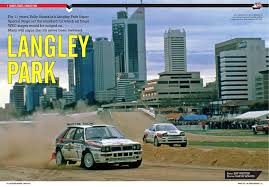
Rally Cars racing two at a time side by side on a short dirt track – the Super Special Stage was born. Langley Park included a jump, a tunnel and a blast along Riverside Drive. Coupled with the main service park, headline act concerts and fireworks there was plenty to see and do. The central hub of Rally Australia would become the benchmark for all other WRC events.
Group A
Group A was maturing as the premier class of the WRC and Rally Australia shared in its heyday. During the early to mid 90’s no less than 10 manufacturers competed at Perth’s round. Whilst Mazda took the early initiative, it would be their only win.
The Big Five
Toyota won twice with their Celica GT4. Lancia’s Delta Integrale won three times with Subaru (Impreza WRX) and Mitsubishi (Evolution) winning once each. Ford used their specially developed Escort Cosworth RS however didn’t make it to the top of the podium.
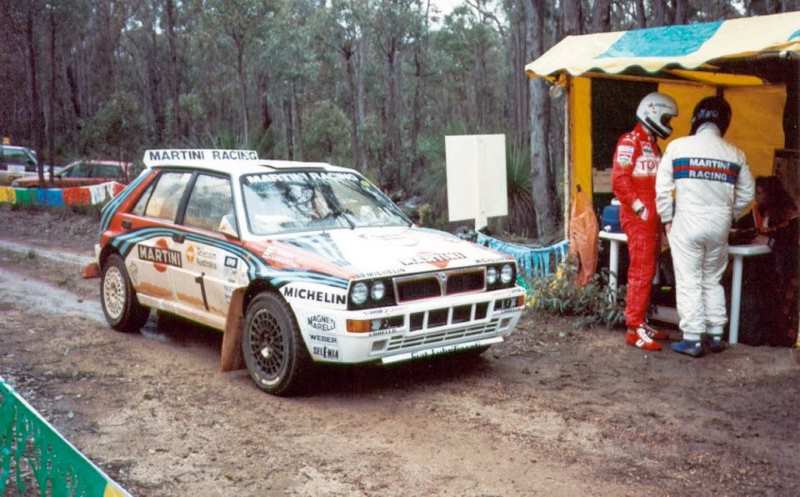
2WD
There were plenty of 2wd manufacturer entries as well. Hyundai brought their Lantra with some success and Vauxhall used their Astra. Rover entered a couple of Minis one year and the novelty was the East German two stroke engine Trabant. Suzuki used their Swift to great effect and VW were also in the throng with their Golf GTi.
Daihatsu
One of the serious 2WD challenges came from the works Daihatsu team. Daihatsu sponsored the Australian Rally Championship in the early 90’s and provided course and celebrity challenge cars for Rally Australia. The Charade GTTi and then Detomaso would prove highly competitive taking some of the 2wd wins.
Lest we forget
1993 would be the darkest year in the history of Rally Australia. Peter “Possum” Bourne and his co-driver Rodger Freeth were tackling the Helena North stage early in the event. Their works Subaru Legacy left the road and hit a tree. Bourne was uninjured however Freeth was not so lucky and succumbed to internal injuries a couple of hours later.
Rodger had a long motorsport career and was highly regarded within the sport. From then on, Bourne would carry the number plate “Roj” on all of his competition cars. Rally Australia also organised a memorial that was erected nearby to the accident site.
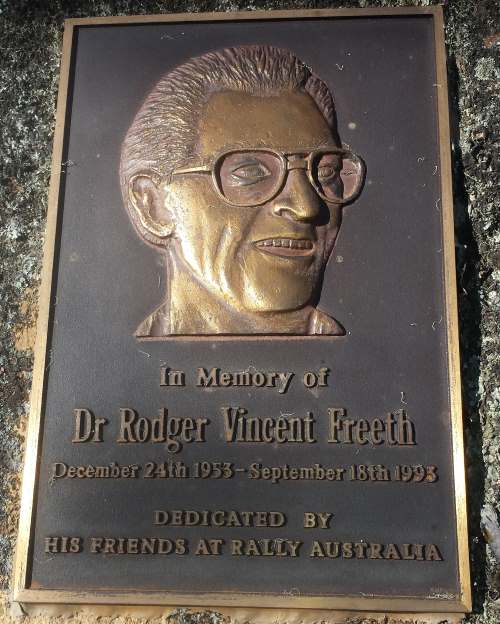
The birth of the World Rally Car
Continuing in the chronology 1997 would see World Rally Cars enter Rally Australia with Subaru and Ford being the first. The new generation cars were a clever departure from pure production based machinery. It was Colin McRae/Nicky Grist that had one of the most memorable moments that year. Going over the famous Bunnings Jumps, the pair flew their Impreza WRC higher than anyone else and also won the rally.
World’s Best Rally
During the last few years of the 20th century Rally Australia’s reputation surpassed most other events. In 1995 and 1999 the WRC teams voted the Perth event “Rally of the Year”. The honour was again bestowed in 2000.
The clouds start forming
In the early 00’s there were rumblings that things weren’t all well beneath the surface. The media started to report stories that Perth was to lose the rally. It seemed that some internal politics were affecting what was the best event on the WRC circuit. In late 2001 Garry Connelly was working on his exit strategy as he felt the writing was on the wall.
No one can understand the reasoning
By the mid 00’s the writing wasn’t just on the wall, it was official. Straight after a state election in 2005 the freshly elected Labor party dropped a bombshell. Rally Australia was to be cancelled, citing financial viability as the reason. It sent shock waves through the community. How could an event that was voted the world’s best and gave so much back to Western Australia be unviable?
Realistically the decision to drop Rally Australia from Perth had nothing to do with money. It was the only out clause the Government had with the FIA in pretty much a water tight contract. Politics played their part and the government refused to overturn the decision despite many organised protests.
The impossible
2005 was memorable for another reason. Skoda had been running in the WRC for a few seasons without success. They had decided to withdraw from the WRC after Rally Australia. Colin McRae/Nicky Grist were at a loose end and Skoda invited them for a one off drive in Perth. With no championship to think about they got stuck in.
No one expected Skoda to do anything except make up the numbers. McRae/Grist had other ideas and got the Fabia into 3rd place. They were making ground on 2nd and it was looking good for a podium on Skoda’s very last WRC event.
At the last service the team attempted a routine clutch replacement. It was a task they’d tackled many times before. This time the mechanics had trouble getting the gearbox back in the car. It took much longer than the time allowed and Skoda was forced to retire. Such were the heroic efforts of the team and drivers that all in the service park gave them a standing ovation. It was also McRae’s last Rally Australia however no one knew it at the time.
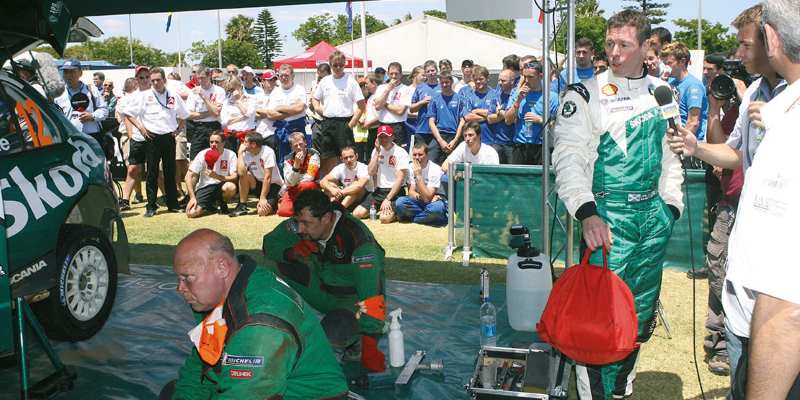
05 the last, or was it?
Despite all the trumpeting Rally Australia again ran in Perth in 2006. For the WA Government to exit their contract, they had to find another state to take it on. There were no takers at the end of 2005 and so WRC teams headed to Western Australia one last time. The after party was a sombre affair… Perth had also lost its only big international event.
Two years without Rally Australia
As of 2007 the Australian round of the WRC was to relocate to Queensland. Unfortunately due to several issues the event did not run and was dropped from the calendar. Again there was no event in 2008. Some wondered whether Rally Australia had been lost forever.

Controversy on the return
In 2009 Rally Australia was re-born. The area chosen for hosting was northern New South Wales. That particular area of the country has a very strong green movement. From the outset there was opposition to a motorsport event in the area. Sure enough when the rally ran there were several protests. Some residents attempted to disrupt the rally and caused safety concerns. Even worse rocks were thrown at some competing cars smashing several windows. It was a PR nightmare for the organisers.
For the next couple of years Rally Australia would alternate on the WRC calendar with New Zealand. When NSW’s turn came again in 2011 the event had changed location. The Rally was now based around Coffs Harbour where it continues to this day.
Successes
So far Juha Kankkunen is the most successful driver to have contested Rally Australia with four wins to his name. Marcus Gronholm, Miko Hirvonen and Sebastian Ogier all have three wins apiece. Volkswagen have been the most successful manufacturer taking four consecutive wins from 2013-2016. Lancia, Subaru, Mitsubishi, Peugeot and Ford have all won three times.
Losses
Three drivers are no longer with us. Curiously they all won championships and were works drivers for the same team, Subaru. Possum Bourne lost his life in a road accident in 2003. Richard Burns won Rally Australia in 1999 and succumbed to cancer in 2005. Two time Rally Australia winner Colin McRae died in a helicopter crash in 2007. All are still sadly missed and the sport is poorer for their passing.
Thirty years on, many people look back fondly. Bringing a round of the WRC down under was no easy feat and it was well worth the effort. The event brings dedicated people together in a way outsiders don’t understand. It’s an adventure, an experience and a community all wrapped into one. There’s no doubt that our sport is much richer for having Rally Australia on our shores. May it continue for many years to come.
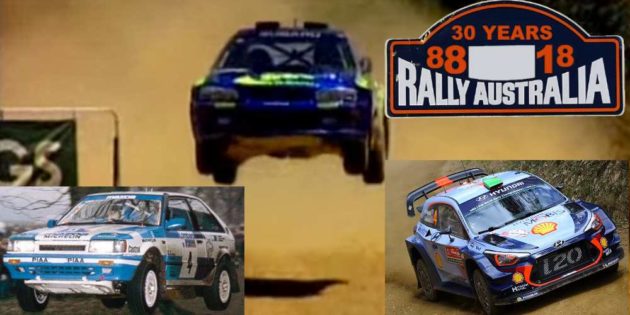

2 Comments
Laurie Price
17/04/2020Started out as a spectator marshal in 1989 where I narrowly missed getting smashed by Didier Auriol while keeping the general public out of harms way.
After a couple of years I was able to progress to road closures which ended up being the best of all duties.
Volunteered for every rally, every day, even though it involved almost no sleep and a lot of hard work.
My family and friends became very involved which was a great incentive to keep going. My son even became a road closure official in the latter years.
We still talk about how good it was, how great it was to watch and how good the top boys were.
So sad it has gone from Western Australia.
We were an icon
Rally Action
06/05/2020Laurie, they certainly were the good old days!
Leave A Response